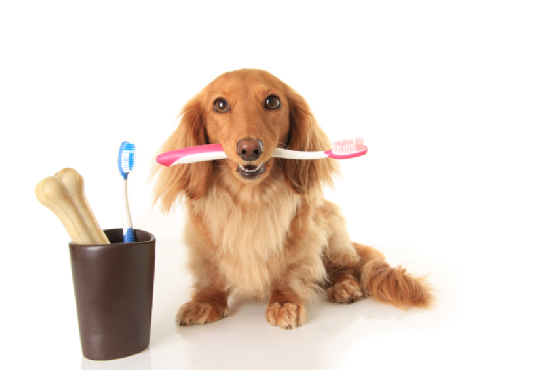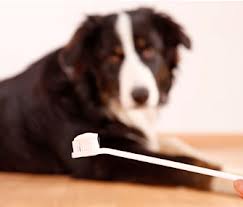February is Pet Dental Health Month!
Don’t turn your nose to Fido’s or Fluffy’s bad breath!
That odor might signify a serious health risk, with the potential to damage not only your pet’s teeth and gums but its internal organs as well.
Bacteria and plaque-forming foods can cause build-up on a dog’s teeth. This can harden into tartar, possibly causing gingivitis, receding gums and tooth loss. One solution? Regular teeth cleanings, of course.
Brightening the pearly whites
Taking these steps will make brushing a lot easier for the both of you:
- First get your dog used to the idea of having her teeth brushed. Massage her lips with your finger in a circular motion for 30 to 60 seconds once or twice a day for a few weeks. Then move on to her teeth and gums.
- When your pooch seems comfortable being touched this way, put a little bit of dog-formulated toothpaste or a paste of baking soda and water on her lips to get her used to the taste.
- Next, introduce a toothbrush designed especially for dogs—it should be smaller than a human toothbrush and have softer bristles. Toothbrushes that you can wear over your finger (or a clean piece of gauze) are also available and allow you to give a nice massage to your dog’s gums.
- Finally, apply the toothpaste to her teeth for a gentle brushing.


Brushing technique
Yes, there is actually a technique! Place the brush or your gauze-wrapped finger at a 45-degree angle to the teeth and clean in small, circular motions. Work on one area of your dog’s mouth at a time, lifting her lip as necessary. The side of the tooth that touches the cheek usually has the most tartar, and giving a final downward stroke can help to remove it. If your dog resists having the inner surfaces of her teeth cleaned, don’t fight it—only a small amount of tartar accumulates there. Once you get the technique down, go for a brushing two or three times a week.
Chew on this
Chew toys can satisfy your dog’s natural desire to chomp, while making his teeth strong. Gnawing on a chew toy can also help massage his gums and help keep his teeth clean by scraping away soft tartar. Ask your vet to recommend toxin-free rawhide, nylon and rubber chew toys.
Diet for healthy teeth
Ask your vet about a specially formulated dry food that can slow down the formation of plaque and tartar. Also, avoid feeding your dog table scraps, instead giving him treats that are specially formulated to keep canine teeth healthy.
Also useful: check out this step-by-step instructions by the American Veterinary Medical Association on how to teach a dog to accept a daily tooth brushing and tips on healthy treats, and chew toys.
Sources: www.aspca.org, www.avma.org
